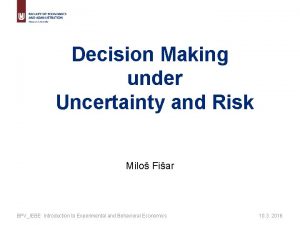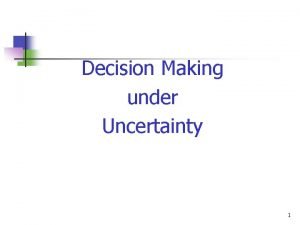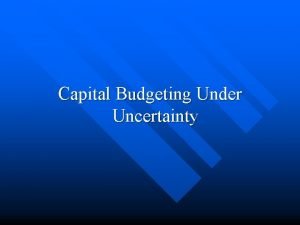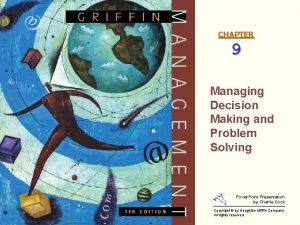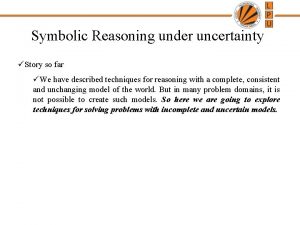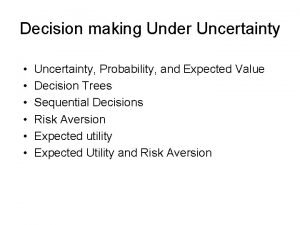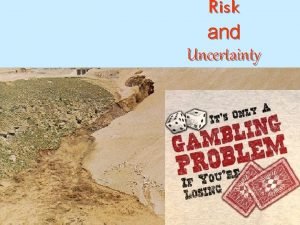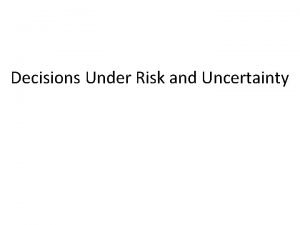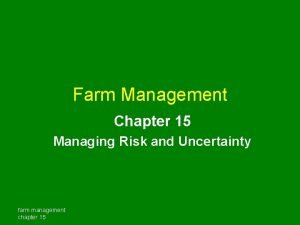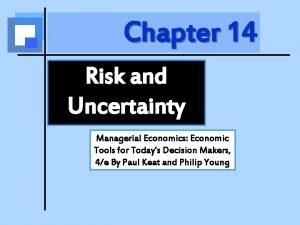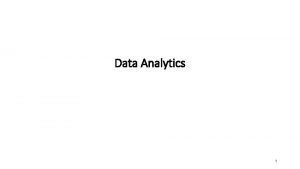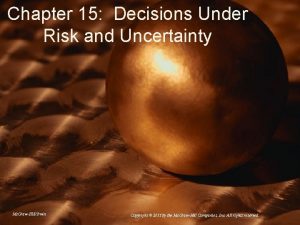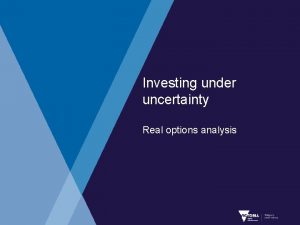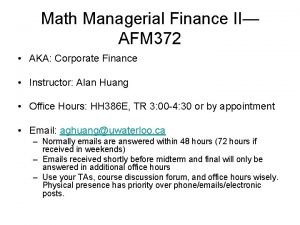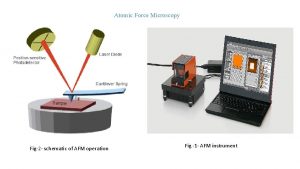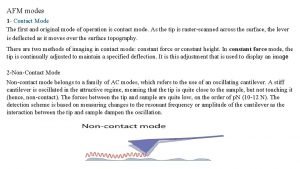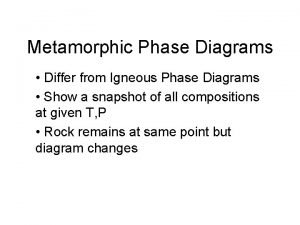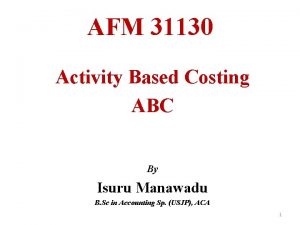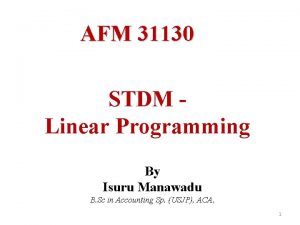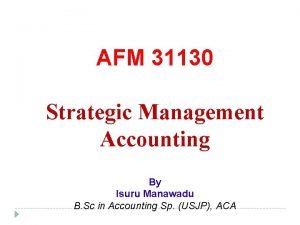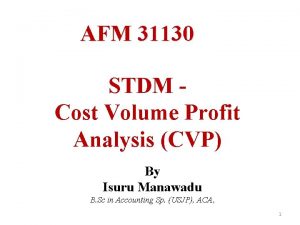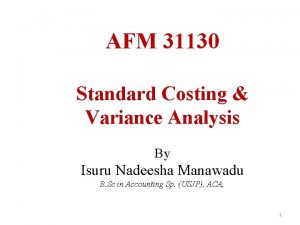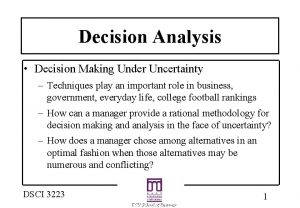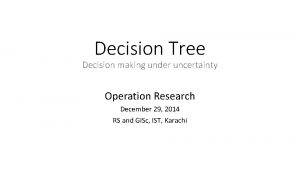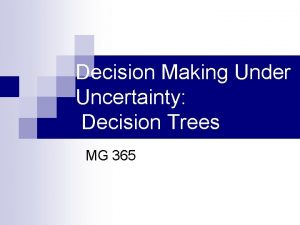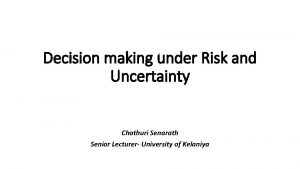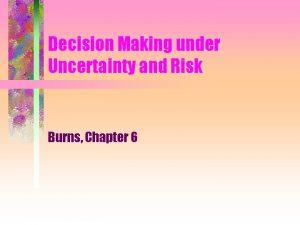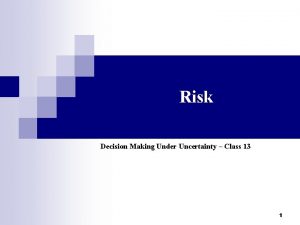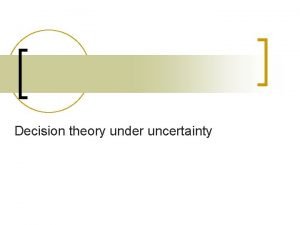AFM 31130 Decision Making Under Uncertainty and Risk





































- Slides: 37

AFM 31130 Decision Making Under Uncertainty and Risk By Isuru Manawadu B. Sc in Accounting Sp. (USJP), ACA, 1

Learning Outcomes After studying this session you will be able to: üRisk, uncertainty and probability üMeasuring Uncertainty üExpected value üAdvantages and disadvantages of expected value üVariance üSlandered Deviation üExpected utility Theory

Decisions • Decision making without taking uncertainty into consideration • Decision making under uncertainty

Decision making under uncertainty • Non probabilistic Approach • Probabilistic Approach

Decision Making Models • • • Identified Objective Identified alternatives Identified states of nature Possible outcomes Measurement of the value of payoffs Select the best course of action

Question 01 Araliya PLC is reviewing its marketing policy for next budget period. It has developed two new product A and B. But it only has sufficient recourses to launch one of them. Required to; Illustrate the application of decision making model concept to solve the above problem.

Answer Step Remarks Objective Maximize the profit Decision alternatives Product A Product B Do nothing Status of nature Competitors will; Do nothing Introduce comparable product Introduce a superior product Possible outcomes Slight increase in profit Slight decrease in profit Large increase in profit Large decrease in profit No change in profit Measure payoff Select best course of action

Risk, Uncertainty and Probability Risk- Applied where there are several possible outcome and there is a relevant past experience with statistical evidence enabling a qualified degree of prediction of the possible out come. Uncertainty- Where there are several possible outcome but there is little previous statistical evidence to enable the possible outcomes to be predicted.

Risk, Uncertainty and Probability Cont…. Probability- Quantification of uncertainty or measurement of degree of risk.

Risk and uncertainty Risk • Must make a decision for which the outcome is not known with certainty • Can list all possible outcomes & assign probabilities to the outcomes Uncertainty • Cannot list all possible outcomes • Cannot assign probabilities to the outcomes

Probability • Objective Probability • Subjective Probability

Probability Distribution • Discrete probability distribution v. Probability will be assigned to finite number of possible outcomes • Continuous probability distribution v. Used for the continuous variables and point estimate of probabilities are not possible.

Measuring Risk with Distributions Probability • Table or graph showing all possible outcomes/payoffs for a decision & the probability each outcome will occur. • To measure risk associated with a decision Examine statistical characteristics of the probability distribution of outcomes for the decision

Probability Distribution for Sales

Expected value The expected value is calculated by multiplying each of the financial outcomes by its associated probability.

Expected Value Expected value (or mean) of a probability distribution is: Where Xi is the ith outcome of a decision, pi is the probability of the ith outcome, and n is the total number of possible outcomes

Expected Value • Does not give actual value of the random outcome • Indicates “average” value of the outcomes if the risky decision were to times

Question 02 Kalana PLC is consedering whether to make product A or B. The estimated sales demand for the product A and B are uncertain. A detail investigation of possible sales demand for each product gives the following probability distribution of the profit for each product. Product A Probability Product B Probability Distribution Outcome Estimated Profit (in Mn) Probability 600 0. 1 400 0. 05 700 0. 2 600 0. 1 800 0. 4 900 0. 2 1000 0. 25 1000 0. 1 1200 0. 2

Expected Value - Advantages • Simple to understand calculate • Represents whole distribution by a single figure • Arithmetically takes account of the expected variabilities of all outcomes

Expected Value - Disadvantages • By representing the whole distribution by a single figure it ignores the other characteristics of the distribution Eg. Range of skewness. • Make the assumption that the decision maker is risk neutral.

Variance is a measure of absolute risk • Measures dispersion of the outcomes about the mean or expected outcome • The higher the variance, the greater the risk associated with a probability distribution

Identical Means but Different Variances

Standard Deviation • Standard deviation is the square root of the variance • The higher the standard deviation, the greater the risk

Probability Distributions with Different Variances

Coefficient of Variation When expected values of outcomes differ substantially, managers should measure riskiness of a decision relative to its expected value using the coefficient of variation A measure of relative risk

Decisions Under Risk • No single decision rule guarantees profits will actually be maximized • Decision rules do not eliminate risk • Provide a method to systematically include risk in the decision making process

Question 03 Calculate Variance, standard deviation and coefficient of variance for the probability distribution provided in the question 02 Product A Probability Distribution Product B Probability Distribution Outcome Profit (in Mn) 600 700 800 900 1000 Outcome Profit (in Mn) 400 600 800 1000 1200 Estimated Probability 0. 1 0. 2 0. 4 0. 2 0. 1 Estimated Probability 0. 05 0. 1 0. 4 0. 25 0. 2

Summary of Decision Rules Under Conditions of Risk Expected value Choose decision with highest expected value rule Mean-variance Given two risky decisions A & B: rules • If A has higher expected outcome & lower variance than B, choose decision A • If A & B have identical variances (or standard deviations), choose decision with higher expected value • If A & B have identical expected values, choose decision with lower variance (standard deviation) Coefficient of variation rule Choose decision with smallest coefficient of variation

Which Rule is Best? • For a repeated decision, with identical probabilities each time • Expected value rule is most reliable to maximizing (expected) profit • Average return of a given risky course of action repeated many times approaches the expected value of that action

Which Rule is Best? • For a one-time decision under risk • No repetitions to “average out” a bad outcome • No best rule to follow • Rules should be used to help analyze & guide decision making process • As much art as science

Expected Utility Theory • Actual decisions made depend on the willingness to accept risk • Expected utility theory allows for different attitudes toward risk-taking in decision making • Managers are assumed to derive utility from earning profits

Expected Utility Theory Managers make risky decisions in a way that maximizes expected utility of the profit outcomes • Utility function measures utility associated with a particular level of profit • Index to measure level of utility received for a given amount of earned profit

Manager’s Attitude Toward Risk • Risk averse If faced with two risky decisions with equal expected profits, the less risky decision is chosen • Risk loving Expected profits are equal & the more risky decision is chosen • Risk neutral Indifferent between risky decisions that have equal expected profit

Pay off tables The application of probability concept to business decision making, pay off table refer to a matrix that provides pay-offs for all the possible combinations of decision alternatives and events This can be used to solve problems that involve only one decision variable.

Layout of a pay-off table Alternative 01 Alternative 02 Alternative 03 Event 01 Pay-off Pay-off Event 01 Pay-off Expected value (EV) EV – Alternative o 1 Alternative o 2 Alternative o 3

Question 04 A book shop sells expensive monthly magazine at Rs. 1, 000 per copy. The purchasing price of a magazine is Rs. 600 per copy. Bookshop can not return any unsold copies at the month end. How ever, they can sell those at Rs. 500 per copy to a local bookshop. The probability distribution for the monthly demand is as follows. Demand per month Probability 4 0. 10 5 0. 35 6 0. 30 7 0. 25

Thank you
 Decision-making under uncertainty
Decision-making under uncertainty Decision-making under uncertainty
Decision-making under uncertainty Capital budgeting under risk and uncertainty
Capital budgeting under risk and uncertainty Non programmed decision example
Non programmed decision example Objectives of decision making
Objectives of decision making Financial management process
Financial management process Market risk assessment
Market risk assessment Minimalist reasoning in ai
Minimalist reasoning in ai Expected profit under uncertainty
Expected profit under uncertainty Risk and uncertainty continuum
Risk and uncertainty continuum Risk and uncertainty difference
Risk and uncertainty difference Risk and uncertainty in farm management
Risk and uncertainty in farm management Risk and uncertainty in managerial economics
Risk and uncertainty in managerial economics Which decision model incorporates the uncertainty element
Which decision model incorporates the uncertainty element Uncertainty vs risk
Uncertainty vs risk Risk versus uncertainty
Risk versus uncertainty Decision tree and decision table examples
Decision tree and decision table examples Geologia
Geologia Uwace.uwaterloo.ca
Uwace.uwaterloo.ca Scuola deffenu olbia
Scuola deffenu olbia Baggi registro elettronico
Baggi registro elettronico Afm welfare
Afm welfare Afm basics
Afm basics Stm tutorial
Stm tutorial Scanning probe microscopy applications
Scanning probe microscopy applications Afm modes of operation
Afm modes of operation Afm schematic
Afm schematic Contact mode afm
Contact mode afm Afm
Afm Afm mfm tutorial
Afm mfm tutorial Afm
Afm Metamorphic rocks phase diagram
Metamorphic rocks phase diagram Afm
Afm Spm afm
Spm afm Afm teknoloji
Afm teknoloji Using recursion in models and decision making
Using recursion in models and decision making Using functions in models and decision making
Using functions in models and decision making Chapter 6 prices and decision making assessment answers
Chapter 6 prices and decision making assessment answers
